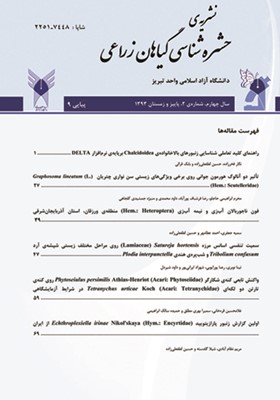تولید صدا در آبدزدک اروپایی (L.) (Orthoptera: Gryllotalpidae)، جمعیت شمال غرب ایران
محورهای موضوعی : حشره شناسی گیاهان زراعی
محمدحسین کاظمی 1 , شبنم جعفری 2 , حسینعلی لطفعلی زاده 3 , محمد جعفرلو 4 , نادر وحدانی مناف 5
1 - هیات علمی گروه گیاهپزشکی، دانشگاه آزاد اسلامی واحد تبریز
2 - دانش آموختهی کارشناسی ارشد حشرهشناسی کشاورزی دانشگاه آزاد اسلامی واحد تبریز
3 - بخش تحقیقات گیاهپزشکی، مرکز تحقیقات کشاورزی و منابع طبیعی استان آذربایجان شرقی
4 - بخش تحقیقات گیاهپزشکی، مرکز تحقیقات کشاورزی و منابع طبیعی استان آذربایجان شرقی
5 - دانشجوی کارشناسی ارشد مهندسی معماری کامپیوتر دانشگاه آزاد اسلامی واحد تبریز
کلید واژه: آبدزدک اروپایی, Ensifera, آواز فراخوانی, دالان صوتی,
چکیده مقاله :
تولید صدا در روابط و رفتار های بسیاری از حشرات نقش مهمی دارد. سامانه صوتی در آبدزدک ها، اغلب در روابط درون گونه ای استفاده می شود که بخش مهمی از فرایند تولید مثلی آن ها است. الگو و فرکانس این اصوات مختص هر گونه می باشد. افراد نر آبدزدک اروپایی (Linnaeus, 1758) gryllotalpa Gryllotalpaبا مالش دادن بال های جلویی خود به یکدیگر صدا تولید می نمایند. در این فرایند، عضو موسوم به سوهان که در بخش خارجی بال های جلویی قرار دارد به دندانه های موجود در سطح زیرین رگبال Cu2 مالش داده می شود که تعداد آن ها در جمعیت مورد مطالعه90-84 عدد شمارش شد. افراد نر برای تولید صدا اقدام به حفر دالان صوتی می نمایند که بر اساس این بررسی، دالان های مذکور در مناطق مورد مطالعه، دارای یک ورودی در سطح خاک بودند. شکل دالان ها جهت تقویت صدا شیپوری بود که در انتها به دو یا سه دالان افقی ختم می شدند. افراد نر در داخل دالان صوتی به طور متوسط حدود نیم ساعت (15 تا 46 دقیقه) آواز می خواندند. این صدا اغلب در عصر روزهای گرم فصل بهار به گوش می رسد و ماده ها را برای جفت گیری جلب می نماید.
Acoustic system has an important role in communication and behavior of several of insects. In mole crickets, acoustic signals are used for intraspecific communications. It is an important part of their reproductive system that temporal patterns and frequency components of these songs are species specific. Males of the European mole cricket, Gryllotalpa gryllotalpa (Linnaeus, 1758) stridulate by rubbing of their forewings to each other. In this process, the scraper on the posterior margin of the forewing is rubbed by a file bearing 84-90 pegs in the population studied. The stridulatory pegs are placed under surface of the Cu2 vein. Base on results of the present study males excavate an acoustic chamber for sound production. These burrows have one entrance to the soil surface. They were horn shaped and this special pattern amplifies the sound. Each acoustic burrow terminates to two or three horizontal tunnels. Males called for approximately half an hour (ranged 15–46 min) typically. This can often be heard on warm evenings of the spring and attracts the females for mating.
Alexander RD. 1962. Evolutionary change in cricket acoustical communication. Evolution 16: 443-467.
Brandenburg RL, Williams CB. 2002. Mole cricket management in NC. [Available online]: http://www.turffiles.ncsu.edu/articles/tf0054.aspx (accessed 15 June 2010).
Bennet-Clark HC. 1970. The mechanism and efficiency of sound production in mole crickets. Experimental Biology 52: 619-652.
Bennet-Clark HC. 1998. Size and scale effects as constraints in insect sound communication. Philosophical Transactions of the Royal Society of London B 353: 407-419.
Bennet-Clark HC. 1999. Resonators in insect sound production: How insects produce loud pure-tone songs. Experimental Biology 202: 3347-3357.
Chapman RF. 1998. Mechanical communication: Sound production and substrate vibrations. In: The insects Structure and Function. 4th ed. pp.680-701.
Doherty JA, Callos JD. 1991. Acoustic communication in the trilling field cricket, Gryllus rubens (Orthoptera: Gryllidae). Insect Behavior 4: 67-82.
Figg DE, Calvert PD. 1987. Status, Distribution and Life History of the Prairie Mole Cricket, Gryllotalpa major Saussure. Missouri Department of Conservation, Jefferson City, MO.
Forrest TG, Green DM. 1991. Sexual selection and female choice in mole crickets (Scapteriscus: Gryllotalpidae): Modeling the effects of intensity and male spacing. Bioacoustics 3: 93-109.
Greenfield MD, Tourtellot MK, Snedden WA. 1997. Precedence effects and the evolution of chorusing. Biological Sciences 264: 1355-1361.
Hill PSM. 2000. Elements of the acoustic repertoire of the prairie mole cricket (Orthoptera: Gryllotalpidae: Gryllotalpa major). Kansas Entomological Society 73: 95-102.
Hill PSM, Hoffart C, Buchheim M. 2002. Tracing phylogenetic relationships in the family Gryllotalpidae. Journal of Orthoptera Research 11: 169-174.
Howard DR, Hill PSM. 2006. Morphology and calling song characteristics in Gryllotalpa major (Orthoptera: Gryllotalpidae). Journal of Orthoptera Research 15: 53-57.
Huber F, Moore TE, Loher W. 1989. Cricket Behavior and Neurobiology. CornellUniversity.
Kazemi MH, Jafari S, Lotfalizadeh H, Mashhadi-Jafarloo M. 2011. Evaluation on morphological characters of European mole cricket, Gryllotalpa gryllotalpa (Orth.: Gryllotalpidae) in the North-west of Iran. Agricultural Sciences, Islamic Azad University, Tabriz Branch (In press) (In Persian)
Kowalski K, Lakes-Harlan R. 2010. Sounds, behavior, and auditory receptors of the armored ground cricket, Acanthoplus longipes. Insect Science 10(59): 1-15.
Mason AC, Forrest TG, Hoy RR. 1998. Hearing in mole crickets (Orthoptera: Gryllotalpidae) at sonic and ultrasonic frequencies. Experimental Biology 201: 1967–1979.
Nikouei P, Hatami B, Khajehali J, Ebadi R. 2006. Rating system to evaluate damage of mole cricket, Gryllotalpa sp. 17th Iranian Plant Protection Congress, Karaj, 2006, p. 350 (In Persian).
Otte D. 1992. Evolution of cricket songs. Journal of Orthoptera Research 1: 25-49.
Römer H, Bailey WJ. 1986. Insect hearing in the field. Comparative Physiology 159: 627-638.
Ulagaraj SM. 1975. Mole Cricket: Ecology, behavior and dispersal flight (Orthoptera: Gryllotalpidae: Scapteriscus). Environmental Entomology 4: 265- 273.
Ulagaraj SM. 1976. Sound production in mole crickets (Orthoptera: Gryllotalpidae: Scapteriscus). Annals of the Entomological Society of America 62(2): 299-306.


